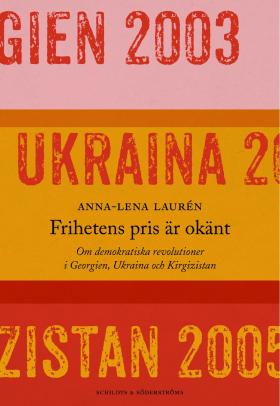
Frihetens pris är okänt. Om demokratiska revolutioner i Georgien, Ukraina och Kirgizistan
(The Unknown Price of Freedom. On democratic revolutions in Georgia, Ukraine and Kyrgyzstan)
by Anna-Lena Laurén
reviewed by Darcy Hurford
‘The problem is the same everywhere: introducing democracy hurts.’ So writes Anna-Lena Laurén, Swedish-speaking Finnish journalist based in Moscow, in the introduction to this book. Given recent developments in Ukraine, the observation seems prescient. Covering the Arab Spring in Cairo in May 2012, Laurén began to wonder how democracy was developing in the former Soviet Union, and particularly in the three states swept by revolutions: Georgia’s Rose Revolution (2003),Ukraine’s Orange Revolution (2004), and Kyrgyzstan’s Tulip Revolution (2005). A long-standing reporter for the Helsinki daily Hufvudstadsbladet, with much experience of reporting from the region, Laurén is well-placed to analyse these three countries.
Considerable thought has gone into making this work not only informative,but also accessible to readers who are not experts on the region. Each chapter opens with a list of basic facts about the country concerned, like population,religions practised and GNP per capita as well as a map and a brief overview of its history. A set of quotes follows, often from the people interviewed in that chapter. It is visually appealing; the text is interspersed with sepia photographs that both evoke the places and people described, and display intrinsic artistic merit.
The first section, ‘Georgia and the essence of democracy’ opens in a Tbilisi filled with grandiose building projects and American PR people, both the result of Mikheil Saakashvili’s reforms. It ends with the transfer of power to Saakashvili’s successor, Bidzina Ivanishvili. Between the two, Laurén builds up a nuanced picture of the country. She describes the boom Georgia experienced, as well as those it did not reach. She speaks to top Georgian politicians, members of the Armenian minority, academics and demonstrators. Not just in Tbilisi – she also visits the Svaneti region, something of a centre for Georgian mythology and a target for Saakashvili’s investment programme. Perhaps unsurprisingly for a Swedish-speaking Finn, Laurén highlights the country’s diversity. Georgian may be the only official language, but there are sizeable Azeri, Armenian and Russian minorities. While most people identify with the Orthodox church, there is also a significant Muslim minority.
Although this book was published in spring 2013, the following chapter on Ukraine still feels timely. While much news coverage seems focused on high-level power politics (what Putin is doing, what the Kremlin is planning), Laurén’s approach of mixing factual background information with reportage based on simply talking to people around the country offers a refreshing counterbalance. She starts with a mining family in Donetsk, a city so frequently in the headlines at the time of writing that one wonders how the family is doing now, and moves on to cover the Orange Revolution and its aftermath. As with Georgia, Ukraine’s sheer diversity comes across clearly. As well as interviewing speakers of Russian and Ukrainian, Laurén visits Crimean Tatars, deported in Soviet times but returning to their original - but unwelcoming - homeland. While Laurén makes the tensions between the two major language groups clear, she does not depict them as critical. Instead, the issue seems to be the hazy nature of Ukraine’s identity: ‘Ukraine is neither one thing nor another. Ukraine is everything at the same time.’
‘They want to introduce the same tax system as in France! But we don’t live like the French. So why should we pay tax?’ asks a taxi driver in Bishkek quoted in the Kyrgyzstan chapter, pointing to one of the problems facing economic reformers. Culturally, economically and politically, Kyrgyzstan is divided into a Russian-oriented north, focused on the capital, Bishkek, where people have traditionally been nomads, and a more Oriental south, where multi-ethnic cities like Osh once formed part of the Silk Route. As with Georgia and Ukraine, there have been ethnic tensions in Osh between Kyrgyz and Uzbek inhabitants with tragic results. Corruption and a clan mentality persist.
All three countries are facing questions of identity, much like older European democracies, as Laurén points out. The world is complex and ambiguous – and that is why democracy hurts.

Frihetens pris är okänt. Om demokratiska revolutioner i Georgien, Ukraina och Kirgizistan
Schildts & Söderströms, 2013. 212 pages.
